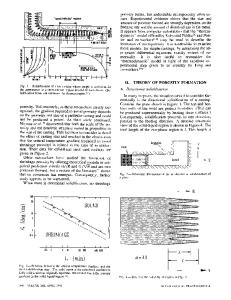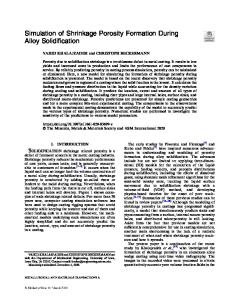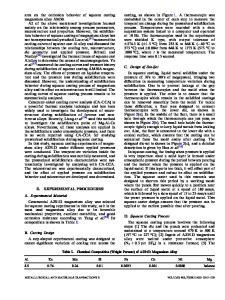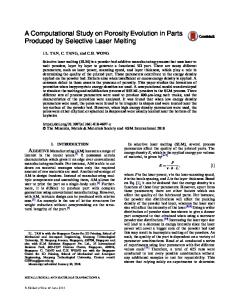A computational study of porosity formation mechanism, flow characteristics and solidification microstructure in the L-D
- PDF / 4,959,178 Bytes
- 12 Pages / 595.276 x 790.866 pts Page_size
- 51 Downloads / 447 Views
A computational study of porosity formation mechanism, flow characteristics and solidification microstructure in the L‑DED process Arvind Chouhan1 · Akash Aggarwal1 · Arvind Kumar1 Received: 6 August 2020 / Accepted: 21 September 2020 © Springer-Verlag GmbH Germany, part of Springer Nature 2020
Abstract Laser-assisted directed energy deposition is an additive manufacturing process used to manufacture metallic parts. The gas porosity is one of the prominent deposition defects in the processed parts. This influences the mechanical properties which can cause the part failure. In this work, the mechanism of gas porosity formation at low energy density is addressed using computational modeling. An investigation is carried out to capture the powder particles interaction with the melt pool and resulting porosity formation, molten pool hydrodynamics, and solidification microstructure in the L-DED process. The numerical results reveal that the stagnant zone in the melt pool leads to entrapment of bubbles which eventually forms porosity. This bubble entrapment phenomenon is studied by varying the powder mass flow rate, and it is found that increasing the mass flow rate results in rapid bubble formation which increases the chances of gas porosity formation. The temperature gradient and cooling rates are used for solidification analysis and prediction of as-solidified grain morphology. Using the empirical relation, the effect of local thermodynamic solidification conditions on the size of the dendritic microstructure is analyzed. The predicted melt pool geometry and porosity morphology agree with the experimental results. Keywords Computation · Defects · Lasers · Melting · Microstructure · Modeling · Molten · Porosity · Solidification
1 Introduction Laser-assisted directed energy deposition (L-DED) process is one of the promising methods for metal additive manufacturing (AM), which is extensively used for fabricating net-shaped and near-net-shaped parts. Using this technique, extremely complex parts of high-performance materials can be manufactured directly from the CAD data. In the L-DED process, the metal powder is fed coaxially or through a set of radially symmetric nozzles in the molten pool generated by laser energy. This deposition is done in a layered approach to fabricate a 3D part. The process has a huge potential in the aerospace and aviation industry for fabricating functional parts of titanium and nickel-based alloys [1, 2], porous surface structures in biomedical implants [3], functionally graded materials [4], in maintenance, repair, and overhaul technology [5, 6], and in the production of steel components for petrochemical * Arvind Kumar [email protected] 1
Department of Mechanical Engineering, Indian Institute of Technology Kanpur, Kanpur 208016, India
industries [7, 8]. However, porosity formation is one of the major bottlenecks inhibiting the usage of the L-DED fabricated parts. In the powder bed fusion-based processes (e.g., selective laser melting), the gas porosity mainly forms due to the collap
Data Loading...











